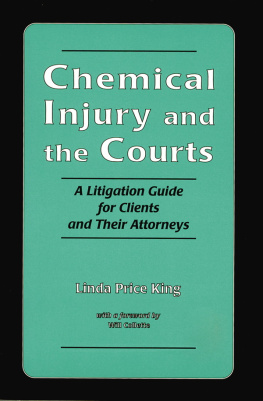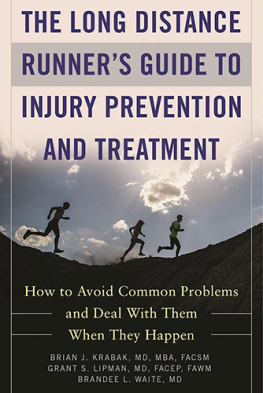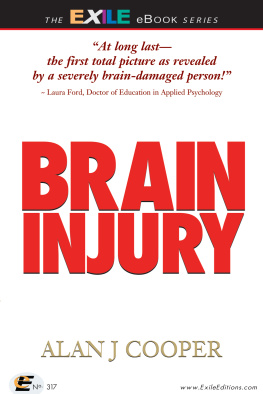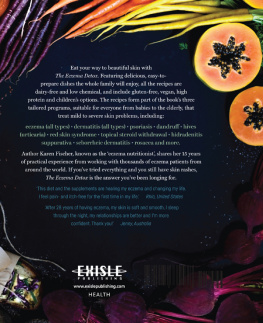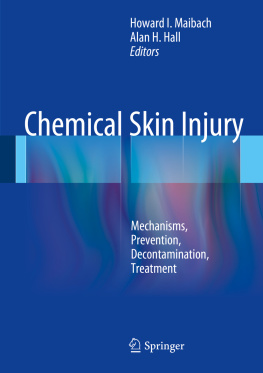
Table of Contents
A project of
The Environmental Health Network
P.O. Box 16267
Chesapeake, VA 23328-6267
(757) 546-0663
FAX (757) 482-9457
e-mail address: ehn22@aol.com
British Library Cataloguing-in-Publication data are available
Library of Congress Cataloguing-in-Publication Data
King, Linda Price, 1952
Chemical injury and the courts : a litigation guide for clients and their attorneys / by Linda Price King ; with a foreword by Will Collette.
p. cm.
Includes bibliographical references and index.
ISBN 0-7864-0624-0
1. Toxic tortsUnited StatesTrial practice. I. Title.
KF8925.P4K56 1999
346.7303'8dc21 99-18628
CIP
1999 Linda Price King. All rights reserved
No part of this book may be reproduced or transmitted in any form or by any means, electronic or mechanical, including photocopying or recording, or by any information storage and retrieval system, without permission in writing from the publisher.
McFarland & Company, Inc., Publishers
Box 611, Jefferson, North Carolina 28640
www.mcfarlandpub.com
Foreword
by Will Collette
When toxic exposure victims look for help, they are looking for more than money. More often than not, they want justice. Victims of environmental exposure often feel like victims of violent crime. Yes, victims want compensation, and they want the letter of the law fulfilled. But most of all, victims want recognition and acknowledgment that a grievous harm has been done to them. They want to know that the perpetrators of the offenses have been punished severely enough to make them rethinkif not regrettheir actions.
That is a tall order. As we all know, the law doesnt necessarily deliver justice. In fact, it often doesnt. Ive worked on Capitol Hill, where laws are crafted with enough loopholes to allow them to be cleverly interpreted and used by parties more interested in profits than in justice. From the moment the legislative process begins to work toward solving a social problem, formidable forces work in tandem to ensure that the legislative solution causes minimal aggravation to the powerful corporate interests that control the workings of Washington.
I walk past the U.S. Supreme Court often and ponder the words inscribed over the portal, Equal Justice under Law, and am reminded of Anatole Frances remark that equal justice under law means that both the rich and the poor are forbidden to steal bread and sleep under bridges.
So what are we to do? By the thousands, the ranks of the injured and the powerless grow. With them grow the cries for real justice. These cries cannot be persistently ignored, and they cannot be denied. Despite the obstacles and the systematic biases against achieving justice, we must try.
As a political organizer, I have devoted my life to helping people find the means to challenge institutional power. Political progress grows out of the courageous act of people joining together to challenge the conditions that control their lives. I really believe that the environmental justice movement can eventually and decisively change the conditions that cause toxic exposure problems. The movement has already made profound changes in our chemical culture and poses a threat to those who assume tomorrows politics will look like todays.
However, no amount of community organizing can give people back what has been stolen from them. As an organizer, I dont know how to help the widow of a worker killed by chemical exposure find the money to raise her kids, or help a person with multiple chemical sensitivities pay the medical bills. I dont know how to help the family that cant live in their poisoned house pay for a new home. If these people are going to get any measure of justice, it must come through many peoples diligent efforts and our legal justice system, however flawed.
I hope you are ready, willing, and able to accept that challenge. I hope this manual will inspire and enlighten clients and their attorneys in their efforts to help find justice for toxic exposure victims.
Preface
Does our legal system understand the needs of toxic exposure victims? Do plaintiff attorneys have the right strategies, resources, and understanding to help clients get compensation? Why is toxic tort litigation so complicated, and can it be streamlined and still serve the clients needs? Are the odds stacked against the injured before they even walk into the courtroom? How, and by whom, are laws being changed to undermine victims rights? Can we change the legal system to bring justice to those whose lives have been changed forever? What steps need to be taken, and by whom, to change the legal system?
These are the fundamental questions raised and examined in Chemical Injury and the Courts. They are examined from the point of view of the client and how the client can become proactive in the legal defense, by working as a member of the team with the attorney to get the best possible results. In order to take on that role, the client needs an understanding of client rights and responsibilities. This book presents a clear blueprint of a clients role and means of empowerment to maximize results from the legal system. Too many times, the victims of chemical exposure are victimized first by the chemicals and then by the legal system that seems to require a complicated and expensive defense.
A chemical injury can happen at any time, to anyone, regardless of age, cultural background, or monetary status. It can happen on the job or in the home and even affect a whole community. It is most often an injury that cannot be avoided by the person or persons exposedthere are no red flags to watch for. It is an injury that often does not show up immediately but develops over a long time. It is the new disease, the mysterious disease, the disease that is highly political, and a disease that could break our economic system if every single case were to be identified, treated, and appropriately compensated.
We call a chemical injury a political injury because of the enormous ramifications of setting a precedent in court for any client or set of clients. Corporate Americas fingers reach from the smallest rural communities to the nations capital. Corporations lobby daily on Capitol Hill, and their interests focus on makingand keepinga profit. (In the eyes of those who have been harmed, these profits come at their expense.)
The chemical industry wields incredible power, not only in the United States but around the world. Their influence and impact reaches from the pharmaceutical industry to the food industry. We, as consumers, are sold inadequately tested products that may be harmful to our health. We live in communities that either manufacture or receive the wastes from such production. But we, as citizens, are often not fully informed (sometimes not informed at all!) about the potential for harm before a product is manufactured, sold, or disposed of. Trade secret laws are used to prohibit people from understanding the full details and depth of their exposures.
Lack of scientific knowledge, or scientific knowledge that is biased toward the industry that pays for the scientific research, is another problem. This bias can even manifest itself in the form of a university research project that is funded by grants from the chemical industry. Even government research, whose legislative approval is affected by lobbying and donations from industry, has a strong potential for such bias. Consumers are vulnerable to an industry with a history of exploiting those who make or use the products (or live near their manufacturing or disposal sites.) Because profits yield power in our society, laws that were once there to protect and support victims rights are slowly being erodedfrom workers compensation laws to punitive damage laws. As states become more conservative in their leadership, so the ability increases for corporate managers to have their desires fulfilled over the desires of the individuals. As the federal government becomes more conservative, so do the federal judges that are appointed or elected, all of which challenges those who are seeking justice for injuries that threaten corporate dynasties.
Next page
